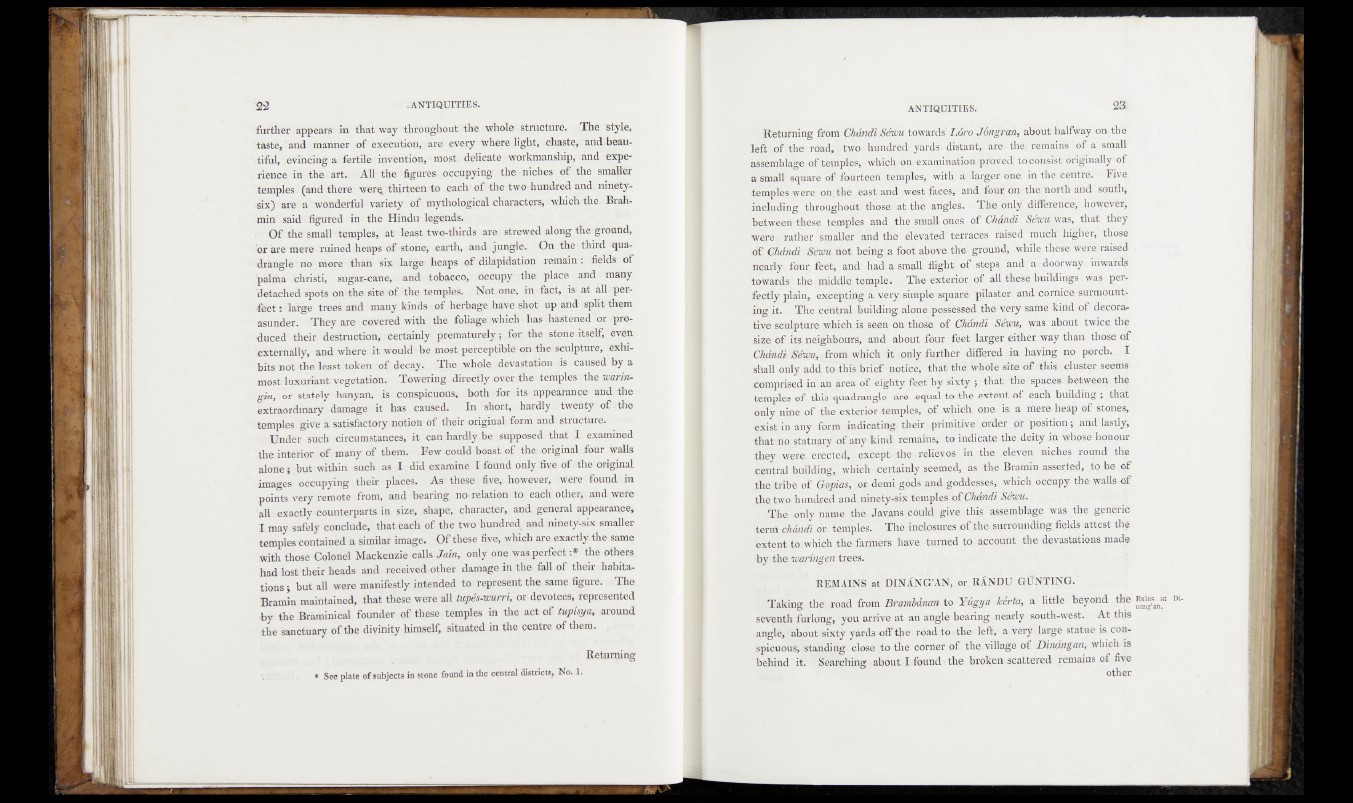
further appears- in that way ~tKroughout<'the whole * structure. The style,
'taste, * and ■ manner. of execution, are* every where light, .chaste, rand- beau-
‘ -tiful, - evincing a -fertile 'invention, -most, delicate-workmanship,- and fexpe-
- xience in the art. All- the* figures o occupying the^niches of the smaller
'temples (and-there ' wer^ thirteen'to each' of the twoihundred and ninety-
:six) -are a wonderful variety of-mythological‘characters,-.which.the Brahmin
said ; figured in the 'Hindu ■ legends.’
; O f the small :temples, at'least two-thirds are- strewed along the ground,
or are mere ruined heaps of stone,- earth, and- jungle: On the third quadrangle
'no more than six large heaps of dilapidation remain: fields.of
palma christi, sugar-cane, and tobacco, occupy ‘the pkce^and many
’detached spots on the site of-the temples. 'Not»one, -in>'.fstct,:.isi at allaper-
fect: large tirees and many kinds“df herbage Fave shot .up~and: split them
asunder. They are' covered with the foliage .which, haslhastenedTori produced
their destruction, certainly prematurely pffor;. thp>st®ne .itself even
externally, and where1 it would be most! perceptible on-dbejsculpture, .exhi-
bits'not the least token/of deeay, ;The whole (-de vastation ^is ' 'cansed ^by-’a
most luxuriant vegetation. (.Towering directly-cver.the^ temple’s dhe '®arin-
gm, or stately banyan, is conspicuous, both for its-appearance and^he
extraordinary damage it has caused. In »short, • hardly îtwehty ofrihe
temples_give a satisfactory notion of their originakform. and structure.
;r-Under such circumstances,'it'can-hardly be:supposed-.that I . examined
the interior of many of them. - Few could‘boast- of the, (original <,four walls
alone; but within such as I did examine Tfound only?fiveofethe original
images occupying their places. As these five, however, -.wele^ound^in
points very remote from, and bearing no-relation‘ to each-other; r and-were
all exactly counterparts in size, .shape, character, and general appearance,
I may safely conclude, that each of the two hundred^- and-ninety'-si-X'smàJler
temples contained a similar image. O f these five, which are. exactlydbei same
.with those Colonel Mackenzie calls Jain, only one was perfect :* the others
had lost their heads and received other damage in-the fall of their habitations;
but all were manifestly intended to represent the same figuré., The
'Pramin maintained, that these were all tupés-wurri, or devotees, represented
by thé Bràminical founder-of these temples in the:actof: tfipi^a, around
•the sanctuary of the divinity himself, situated in the centre of them. .
Returning
Returning fiomtdShdndi SStm towards' Lom Jon gran, about halfway on the
left ofrthe# roadj:-. two- hundred, yards! distant are-' thej remains of. a small
assemblag^-o^pnplesi. whicfo4 iji exaniihatiorf»pjmse^ tocdhsis^originally of
a small1 square- of (fourteen temples, with a-.larjeriorie in the centre. Five
temples were on;thb east, add- west*faces;: and tfou^ car rthe* north and south;
including throughout,' tffose. at th'ea,angles! - Thu,only difference, however,
jjgt.weenlfiese1 temples and ^the smalL onqs^of Chdndi SSwu^ was, that they
were rather’§ifipUel,l/and the'SfevateiF terraces raised much higher, those
of Ghatndi Seim riot- being-a foot above t|reiJ ground; .while these* were raised
nearly four feet; and had-a-small 'flight of .stepq and a-doorway inward?
towards tfese (middle temple, w »The.exterior' of all these buildings was peri-
,fecfly plain, excepting a very sirfipt(i‘squafe pilaster, and, cornice,surmount?
ing it.^T-he tceintrahbuilding'>£done-pQssessed,the; very same kind of decorative
sculpture which is; seen oh. those’ of Chdndi Sewif, was about twice the
size of its neighbours, and about-four \-fdet (larger either way than, those of
Chdndi which _ i f< only further differed in having -no porch.,I
"'Shall only addtAtBis'bimftirotice, that the whole site of itius cluster seems
.comprised injjaK-area ofil^TtyTeet by sixty.; that- the spaces .between %
temples of- this quadrangle are .equal to, the extent of:]each building; that
only n^ealof the exterior-temples, .of .which; ope: is a mere hpap of stones,
;«xist in any- form-indicating.-their; primitive order pr.position; and lastly
that no statuary .of any kind- remains, (to indicate the deify in whose honour
they were erected, except (the relievosi.ip.- the, eleven, pipheg round the
central building, which .certainly .seemed, as the Bramin asserted, to be of
fhe tribe of Gopias, .or demi gods and_,goddesses, .which occupy- the .walls of
the two 'hundred and ninety-six'temples of Cftondi Seim.
jtiTfhe only, name the Javans .could give this assemblage was the generic
term chdndi 6r temples. • The inclpsures .of the,surrounding fields attest thy
extent to .which the farmers have turned to account the devastations made
•by'the-wiGrfiigett trees.
REMAINS at DINANG’AJ^, or jprANiDj^J&UNTING.
• Taking the-road from Brambdnan tv Ydgya kenta, a little beyond the
seventh furlong, :you arrive at an angle hearing- nearly south-west.. At this
angle,-rifoout-sixty yards off tjie. road to. the left«.' a veryriarge statue is conspicuous,
standing-close ifo tlie comer.of the village pf Dtnangan,. which is
behind it. * Searching j about. L found ■ the broken, scattered remains of five
other
Rains at Ü*
nang’an.